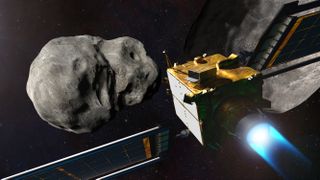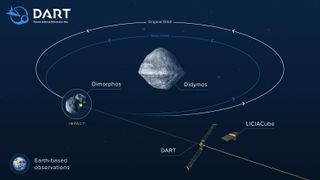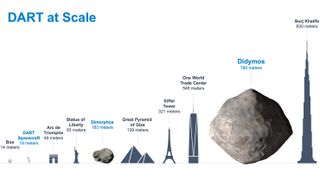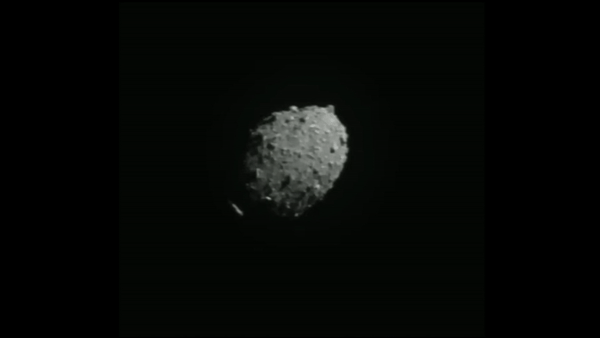NASA's DART asteroid-smashing mission: The ultimate guide
The Double Asteroid Redirection Test (DART) mission successfully crashed a spacecraft into asteroid Dimorphos on Sept. 26, 2022.

NASA's Double Asteroid Redirection Test (DART) mission was designed to test a method of deflecting an asteroid for planetary defense, using the "kinetic impactor" technique.
DART slammed into a small asteroid — Dimorphos — in a bid to change the moonlet's orbital speed by a fraction of a percent according to NASA. Though Dimorphos poses no threat to Earth, the ambitious mission mimics what NASA scientists would do if an asteroid were headed toward Earth.
The collision occurred at 7:14 p.m. EDT (2314 GMT) on Sept. 26, 2022.
Related: NASA's DART asteroid-impact mission explained in pictures

Daisy joined Space.com as a reference writer in February 2022, before then she was a staff writer for our sister publication All About Space magazine.
– Launched: Nov. 24, 2021 at 1:20 a.m. EDT (0620 GMT)
– Launch site: Space Launch Complex 4, Vandenberg Space Force Base in California
– Rocket: SpaceX Falcon 9
– Target: Dimorphos.
– Target distance from Earth: 6.8 million miles (11 million kilometers)
– Estimated cost: $313.9 million (£227.9 million)
– Asteroid impact: Sept. 26, 2022 at 7:14 p.m. EDT (2314 GMT)
The DART mission was launched at 10:20 p.m. local time on Nov. 23, 2021, (1:20 a.m. EDT, or 0620 GMT Nov. 24) atop a SpaceX Falcon 9 rocket from the Space Launch Complex 4 at the Vandenberg Space Force Base in California.
The mission demonstrates the high level of international collaboration that is needed for such an ambitious assignment. Though the DART mission is managed by the John Hopkins University Applied Physics Laboratory (JHUAPL), scientists and engineers from around the world have come together to contribute.
"We've worked really closely with our European colleagues and colleagues all over the world," Ellen Howell, a senior research scientist at the University of Arizona Lunar and Planetary Laboratory and a co-investigator for DART, told Space.com. Though DART is a test, a similar level of international cooperation would be essential in the case of a real impact, she said.
Why is the DART mission important?
Though the threat from asteroid impacts is small, it is a threat nonetheless, and something we should be prepared for. We only need to look at past impact events such as the massive Chicxulub asteroid impact that is credited with the extinction of the dinosaurs 65 million years ago, to see the catastrophic effects an impact can have on life on Earth.
The risk of a catastrophic asteroid impact on Earth is remote but real, NASA scientists have said. NASA has found about 40% of the large asteroids as wide as 500 feet (140 meters) that could pose a threat to the Earth and regularly scans the sky for more. NASA is also developing a new space telescope sentinel called the Near-Earth Object Surveyor specifically designed to seek out hazardous asteroids in the solar system. That mission could launch by 2026.
Early detection of near-Earth asteroids is the first step in planetary defense. Approximately 30 new discoveries of near-Earth asteroids are made each week and at the start of 2019, there were more than 19,000 discovered near-Earth asteroids according to NASA.
DART mission target

DART's target was the binary asteroid system Didymos, which means "twin" in Greek. The system consists of a near-Earth asteroid Didymos measuring 0.48 miles (780 meters) across and its moonlet Dimorphos measuring 525 feet (160 meters) across.
DART deliberately impacted the moonlet Dimorphos at speeds of 4.1 miles per second (6.6 km/s). That's an eye-popping 14,760 mph (23,760 kph).
An impact at this speed should have caused the moonlet's orbital speed to change by a fraction of a percent and this shift should be enough to change its orbital period by several minutes.
According to NASA, the change in Dimorphos' orbit around Didymos was observed and measured by telescopes on Earth, to see whether the mission has succeeded. On Oct. 11, 2022, NASA officially announced that DART shortened Dimorphos' nearly 12-hour orbit by a whopping 32 minutes, smashing previous estimates.
Planetary scientist Nancy Chabot from JHUAPL spoke about the mission strategy with Space.com's sister publication How It Works magazine.

Nancy Chabot is a planetary scientist at the Johns Hopkins Applied Physics Laboratory (APL) and serves as a project scientist on the Double Asteroid Redirection Test (DART) mission.
"One of the major technology challenges of the mission is targeting a small asteroid in space at very high speed when that asteroid has never been imaged by spacecraft previously", Chabot said.
"We know from other asteroids that have been explored that they have a range of shapes, internal structures, surface properties and strengths, and these characteristics will influence how much the asteroid Dimorphos is deflected in its orbit around Didymos."
Related: Why did NASA pick Didymos for its asteroid-crash mission?
DART's journey to Dimorphos

DART was a simple spacecraft. According to JHUAPL, the box-shaped main vehicle measured roughly 3.9 x 4.3 x 4.3 feet (1.2 x 1.3 x 1.3 meters) — about the size of a refrigerator. Each of the two large solar arrays was 27.9 feet (8.5 meters) long when fully deployed. The DART spacecraft contained just one instrument — Didymos Reconnaissance and Asteroid Camera for Optical Navigation (DRACO). (It turns out that if your primary goal is to smash into an asteroid, you don't need to take a lot with you).
Once the DART spacecraft launched on a SpaceX Falcon 9, it deployed its Roll-Out Solar Arrays (ROSA) to power itself for the journey to Didymos. Scientists tested the ROSA arrays onboard the International Space Station in June 2017 and were deemed suitable to provide the power required to support DART's electric propulsion system, according to NASA. (In fact, NASA has added larger versions of the ROSA arrays to the space station's power grid.) The DART spacecraft also used the next-generation, fuel-efficient NASA Evolutional Xenon Thruster-Commercial (NEXT-C) solar electric propulsion system as part of its in-space propulsion.
Related: The greatest asteroid encounters of all time!
According to JHUAPL, DART was guided to its target Dimorphos by sophisticated autonomous navigation software. It's no easy feat to locate a target that is 525 feet (160 meters) in diameter and 6.8 million miles (11 million kilometers) away from Earth. The navigation software was designed to identify both Didymos and Dimorphos and distinguish between the two, so the DART spacecraft can be directed to the smaller body — Dimorphos.
As the spacecraft approached its target, an onboard high-resolution camera — DRACO helped navigate the DART spacecraft and take measurements of the target asteroid, including the size and shape of Dimorphos. DRACO is based on the LORRI camera from NASA's New Horizons spacecraft.
DART asteroid impact

DART successfully slammed into Dimorphos on Sept. 26 at 7:14 p.m. EDT (2314 GMT) in what the U.S. space agency has billed as the world's first planetary defense test.
Despite the on-target crash, there was a mix of calm and anticipation at DART's mission control center at JHUAPL as the spacecraft sped towards its destruction. The crash went smoothly, so engineers didn't have to try one of the 21 different contingency plans they had prepared just in case.
Much of DART's last four hours were automated, with the spacecraft's navigation system locking on to Dimorphos in the final hour of its approach. DART's main camera beamed a photo to Earth every second until the feed went black as the spacecraft crashed into the asteroid. During DART's final moments, photos from the spacecraft revealed stunning details of both Didymos and Dimorphos. The moonlet had never been seen before. DART revealed it as a strange new world, an egg-shaped asteroid covered in boulders and uneven terrain.
DART's companion: LICIACube

According to NASA, the DART spacecraft didn't make its journey to the near-Earth asteroid binary alone, as the spacecraft was joined by LICIACube (Light Italian Cubesat for Imaging Asteroids). LICIACube is a cubesat contributed by the Italian Space Agency and built by Italian aerospace engineering company Argotec.
The small cubesat weighs just 31 pounds (14 kilograms) and measures roughly the length of an adult's hand and forearm. It is fitted with two optical cameras and followed DART towards Dimorphos before settling in to watch the collision from a safe distance — of about 600 miles (1,000 km).
The role of LICIACube was to observe the impact to help confirm whether the experiment has worked.

"LICIACube will … perform a 'fast fly-by' around 3 minutes after DART impact at a minimum distance of about 55 km [34 miles] from Dimorphos' surface at its closest approach," Mazzotta Epifani, an astronomer at Italy's National Institute for Astrophysics (INAF) and a co-investigator on the LICIACube mission, told Space.com in an email.
"The image acquisition by the two cameras onboard will be almost continuous for around 10 minutes and will be devoted to the target impact and non-impact sides, as well as to the plume produced by the DART impact."
LICIACube will then send the images to Earth, but Mazzotta Epifani warned it might take weeks to get down all the data.
All eyes on DART

LICIACube wasn't the only spacecraft to watch the DART asteroid collision, other spacecraft also got in on the action as NASA's new James Webb Space Telescope, the Hubble Space Telescope and the Lucy spacecraft on its own asteroid mission all tracked the crash from their respective vantage points across the solar system.
On Earth, more than three dozen telescopes around the world — at least one on every continent — were trained to follow the binary Didymos-Dimorphos system. They are now poised to observe the pair over six months to investigate how much faster Dimorphos is now moving in its orbit and whether the redirection test has been successful.
What happens next?
The European Space Agency (ESA) is planning a post-impact investigation mission called Hera. The spacecraft is planned to launch in October 2024, according to the mission website and reach the Didymos binary system in December 2026.
ESA's Hera spacecraft will be joined by two cubesats. Together, they will carry out surveys of both Didymos and Dimorphos, paying particular attention to the crater left by DART's collision with Dimorphos. The Hera mission also aims to determine a precise mass of Dimosphos, according to JHUAPL.
Though the two missions, DART and Hera are designed and operated independently, together they will advance our understanding of planetary defense technologies. Team members from both missions are part of an international collaboration known as AIDA — Asteroid Impact and Deflection Assessment. According to ESA, AIDA is a large international collaboration between ESA, the German Aerospace Center (DLR), Observatoire de la Côte d´Azur (OCA), NASA, and the John Hopkins University Applied Physics Laboratory (JHUAPL).
DART is just one part of a larger planetary defense strategy that is led by NASA's Planetary Defence Coordination Office, according to Chabot.
"DART's demonstration of this technology will be a major result to inform future planetary defense activities", she said.
"Finding, tracking and characterizing the near-Earth object population is crucially important to the success of any future planetary defense mitigation efforts, of which DART is just the first test."
Additional resources
You can view images from the JHUAPL DART mission at the mission image galleryAlternatively, learn more about planetary defense with ESA.
Bibliography
–"DART delayed to November launch as environmental testing begins". NASA Spaceflight (2021).
–"DART, NASA's test to stop an asteroid from hitting Earth". The Planetary Society (2022).
–"DART Updates". NASA (2022).
–"DART: Double Asteroid Redirection Test". John Hopkins University Applied Physics Laboratory: DART (2022).
–"DART Impactor". John Hopkins University Applied Physics Laboratory: DART (2022).
Join our Space Forums to keep talking space on the latest missions, night sky and more! And if you have a news tip, correction or comment, let us know at: community@space.com.
Get the Space.com Newsletter
Breaking space news, the latest updates on rocket launches, skywatching events and more!

Daisy Dobrijevic joined Space.com in February 2022 having previously worked for our sister publication All About Space magazine as a staff writer. Before joining us, Daisy completed an editorial internship with the BBC Sky at Night Magazine and worked at the National Space Centre in Leicester, U.K., where she enjoyed communicating space science to the public. In 2021, Daisy completed a PhD in plant physiology and also holds a Master's in Environmental Science, she is currently based in Nottingham, U.K. Daisy is passionate about all things space, with a penchant for solar activity and space weather. She has a strong interest in astrotourism and loves nothing more than a good northern lights chase!
